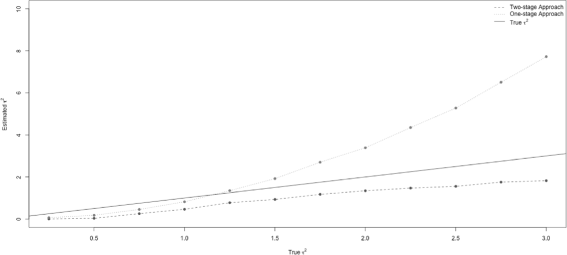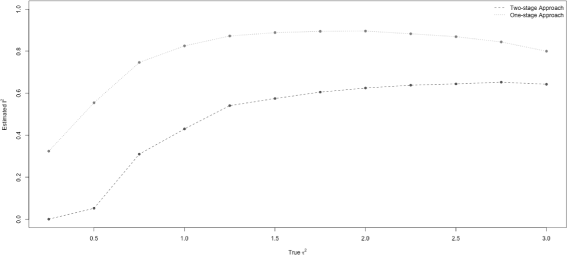Quantifying heterogeneity in individual participant data meta-analysis with binary outcomes
- PMID: 29208048
- PMCID: PMC5718085
- DOI: 10.1186/s13643-017-0630-4
Quantifying heterogeneity in individual participant data meta-analysis with binary outcomes
Abstract
Background: In meta-analyses (MA), effect estimates that are pooled together will often be heterogeneous. Determining how substantial heterogeneity is is an important aspect of MA.
Method: We consider how best to quantify heterogeneity in the context of individual participant data meta-analysis (IPD-MA) of binary data. Both two- and one-stage approaches are evaluated via simulation study. We consider conventional I 2 and R 2 statistics estimated via a two-stage approach and R 2 estimated via a one-stage approach. We propose a simulation-based intraclass correlation coefficient (ICC) adapted from Goldstein et al. to estimate the I 2, from the one-stage approach.
Results: Results show that when there is no effect modification, the estimated I 2 from the two-stage model is underestimated, while in the one-stage model, it is overestimated. In the presence of effect modification, the estimated I 2 from the one-stage model has better performance than that from the two-stage model when the prevalence of the outcome is high. The I 2 from the two-stage model is less sensitive to the strength of effect modification when the number of studies is large and prevalence is low.
Conclusions: The simulation-based I 2 based on a one-stage approach has better performance than the conventional I 2 based on a two-stage approach when there is strong effect modification with high prevalence.
Keywords: Heterogeneity; I 2; Individual participant data meta-analysis (IPD-MA); Two-stage and one-stage approaches.
Conflict of interest statement
Ethics approval and consent to participate
Not applicable.
Consent for publication
Not applicable.
Competing interests
The authors declare that they have no competing interests.
Publisher’s Note
Springer Nature remains neutral with regard to jurisdictional claims in published maps and institutional affiliations.
Figures


References
-
- What Is Meta-analysis? http://www.bandolier.org.uk/painres/download/whatis/Meta-An.pdf. Accessed 5 Mar 2016.
Publication types
MeSH terms
Grants and funding
LinkOut - more resources
Full Text Sources
Other Literature Sources
Medical

